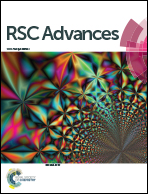Design of a p–n heterojunction in 0D/3D MoS2/g-C3N4 composite for boosting the efficient separation of photogenerated carriers with enhanced visible-light-driven H2 evolution†
Abstract
Constructing a 0D/3D p–n heterojunction is a feasible strategy for accelerating photo-induced charge separation and promoting photocatalytic H2 production. In this study, a 0D/3D MoS2/g-C3N4 (0D/3D-MCN) photocatalyst with a p–n heterojunction was prepared via a facile light-assisted deposition procedure, and the 3D spongy-like g-C3N4 (3D-CN) was synthesized through simple thermolysis of NH4Cl and melamine mixture. For comparison, 2D-MoS2 nanosheets were also embedded in 3D-CN by a solution impregnation method to synthesize a 2D/3D-MCN photocatalyst. As a result, the as-prepared 0D/3D-MCN-3.5% composite containing 3.5 wt% 0D-MoS2 QDs exhibited the highest photocatalytic H2 evolution rate of 817.1 μmol h−1 g−1, which was 1.9 and 19.4 times higher than that of 2D/3D-MCN-5% (containing 5 wt% 2D-MoS2 nanosheets) and 3D-CN, respectively. The results of XPS and electrochemical tests confirmed that a p–n heterojunction was formed in the 0D/3D-MCN-3.5% composite, which could accelerate the electron and hole movement in the opposite direction and retard their recombination; however, it was not found in 2D/3D-MCN-5%. This study revealed the relationship among the morphologies of MoS2 using g-C3N4 as a substrate, the formation of a p–n heterojunction, and the H2 evolution activity; and provided further insights into fabricating a 3D g-C3N4-based photocatalyst with a p–n heterojunction for photocatalytic H2 evolution.



 Please wait while we load your content...
Please wait while we load your content...